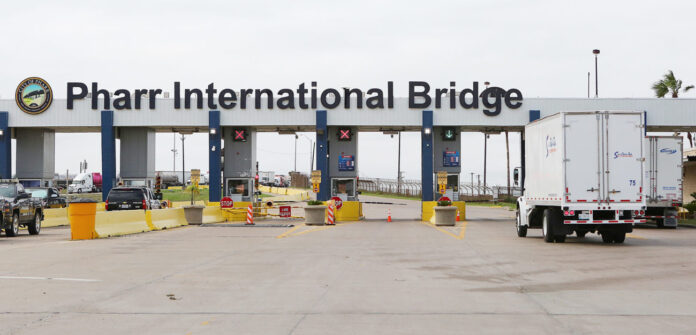
The city of Pharr announced Monday that President Donald Trump issued a presidential permit for the expansion of its international bridge, opening it to more traffic and what officials in the region and state hope will be more trade opportunities for a port that already accounts for 70% of the produce entering the U.S. from Mexico.
The permit will allow additional lanes to completely separate trucks and cars, as well as dedicating specific lanes for empties, full and certified cargo as well as passenger vehicles.
Pharr will also have an official gate-to-gate Free and Secure Trade (FAST) lane, or set of FAST lanes from Mexico to the United States.
With the permit approval, Pharr Mayor Ambrosio Hernandez said the bridge’s capacity will specifically double from four to eight lanes.
He hopes the expansion will be complete by 2023.
“I anticipate that (traffic) will grow by 35, if not almost a good 100%,” Hernandez said. “It will contribute to the tax base in the city of Pharr and its revenue, thereby allowing you to do more projects for the citizens of Pharr and also obviously reduce their tax rate for their property taxes.”
Hernandez said that the project will also create more job opportunities and contribute to the growth in the South Pharr area, noting efforts dating back nearly five years ago to accomplish as much.
“We have always said it was going to happen, since 2015,” Hernandez said. “That’s why we have invested meticulously and generously to the South Pharr infrastructure. Now this is the next piece that was available to us, and it will build upon the previous successes such as we advocated for the (U.S.) 281 exchange — it’s being built.”
He also pointed to the city’s longtime efforts widening the scope of its transportation needs and resources, positioning it for successful expansion plans.
“We advocated for the RMA (Regional Mobility Authority), we have the overweight corridor on Military (Highway) — it’s done,” Hernandez added. “We have the (State Highway) 365 toll road with the MPO (Metropolitan Planning Organization) and the city of Pharr, and of course the leadership of the RMA — they are now going to be breaking ground this year. And of course, the IBTC (International Bridge Trade Corridor), which runs north and south.
“All of this had to be put into place first before the expansion to be able to accept and deal with the capacity that will be coming.”
The bridge project also holds hopes of luring more investors to the area given the increased flow of traffic upon completion of the expansion.
“In the produce business and crossing the bridge when it comes to revenue, time is money,” Hernandez said. “I don’t care if you’re passing petroleum, byproducts of petroleum, fruits, vegetables, automobile parts — whatever it is, you want to get to your final destination as soon as possible to beat out the market. When those trucks are traveling northbound or southbound, in this case the United States into Mexico, time is money.”
U.S. Sen. Ted Cruz, R-Texas, released a statement Monday commending the Pharr mayor and city commission for their work in acquiring the permit.
“I was proud to support the Pharr International Bridge expansion project as millions of jobs, in Texas and across the country, depend upon trade with Mexico,” Cruz said in the release. “I will continue working to ensure future trade opportunities benefit Texas and put American jobs first.”
Hernandez, who credited the work of the city commission, referred to the receipt of the presidential permit as “historic” and noted it took the city 60 days to get the thumbs up when “typically it takes three years to get a permit approved.”
Hernandez also credited the city’s governmental relations department, the board overseeing the Pharr-Reynosa International Bridge and personnel for their role.
“All that together contributed to our success,” Hernandez said. “Of course, we have and will always continue to have a great working relationship despite party lines with the White House leadership, plus Congress, the governor’s office and of course state legislatures. In this case in particular, Sen. Ted Cruz and Sen. John Cornyn were instrumental in pushing and opening doors and making sure that our request was seen.”



